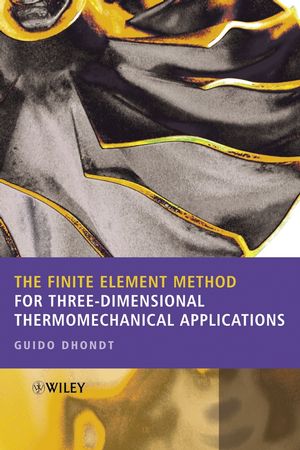The Finite Element Method for Three-Dimensional Thermomechanical ApplicationsISBN: 978-0-470-85752-6
Hardcover
424 pages
June 2004
 This is a Print-on-Demand title. It will be printed specifically to fill your order. Please allow an additional 15-20 days delivery time. The book is not returnable.
|
||||||
Nomenclature.
1 Displacements, Strain, Stress and Energy.
1.1 The Reference State.
1.2 The Spatial State.
1.3 Strain Measures.
1.4 Principal Strains.
1.5 Velocity.
1.6 Objective Tensors.
1.7 Balance Laws.
1.7.1 Conservation of mass.
1.7.2 Conservation of momentum.
1.7.3 Conservation of angular momentum.
1.7.4 Conservation of energy.
1.7.5 Entropy inequality.
1.7.6 Closure.
1.8 Localization of the Balance Laws.
1.8.1 Conservation of mass.
1.8.2 Conservation of momentum.
1.8.3 Conservation of angular momentum.
1.8.4 Conservation of energy.
1.8.5 Entropy inequality.
1.9 The Stress Tensor.
1.10 The Balance Laws in Material Coordinates.
1.10.1 Conservation of mass.
1.10.2 Conservation of momentum.
1.10.3 Conservation of angular momentum.
1.10.4 Conservation of energy.
1.10.5 Entropy inequality.
1.11 The Weak Form of the Balance of Momentum.
1.11.1 Formulation of the boundary conditions (material coordinates).
1.11.2 Deriving the weak form from the strong form (material coordinates).
1.11.3 Deriving the strong form from the weak form (material coordinates).
1.11.4 The weak form in spatial coordinates.
1.12 The Weak Form of the Energy Balance.
1.13 Constitutive Equations.
1.13.1 Summary of the balance equations.
1.13.2 Development of the constitutive theory.
1.14 Elastic Materials.
1.14.1 General form.
1.14.2 Linear elastic materials.
1.14.3 Isotropic linear elastic materials.
1.14.4 Linearizing the strains.
1.14.5 Isotropic elastic materials.
1.15 Fluids.
2 Linear Mechanical Applications.
2.1 General Equations.
2.2 The Shape Functions.
2.2.1 The 8-node brick element.
2.2.2 The 20-node brick element.
2.2.3 The 4-node tetrahedral element.
2.2.4 The 10-node tetrahedral element.
2.2.5 The 6-node wedge element.
2.2.6 The 15-node wedge element.
2.3 Numerical Integration.
2.3.1 Hexahedral elements.
2.3.2 Tetrahedral elements.
2.3.3 Wedge elements.
2.3.4 Integration over a surface in three-dimensional space.
2.4 Extrapolation of Integration Point Values to the Nodes.
2.4.1 The 8-node hexahedral element.
2.4.2 The 20-node hexahedral element.
2.4.3 The tetrahedral elements.
2.4.4 The wedge elements.
2.5 Problematic Element Behavior.
2.5.1 Shear locking.
2.5.2 Volumetric locking.
2.5.3 Hourglassing.
2.6 Linear Constraints.
2.6.1 Inclusion in the global system of equations.
2.6.2 Forces induced by linear constraints.
2.7 Transformations.
2.8 Loading.
2.8.1 Centrifugal loading.
2.8.2 Temperature loading.
2.9 Modal Analysis.
2.9.1 Frequency calculation.
2.9.2 Linear dynamic analysis.
2.9.3 Buckling.
2.10 Cyclic Symmetry.
2.11 Dynamics: The α-Method.
2.11.1 Implicit formulation.
2.11.2 Extension to nonlinear applications.
2.11.3 Consistency and accuracy of the implicit formulation.
2.11.4 Stability of the implicit scheme.
2.11.5 Explicit formulation.
2.11.6 The consistent mass matrix.
2.11.7 Lumped mass matrix.
2.11.8 Spherical shell subject to a suddenly applied uniform pressure.
3 Geometric Nonlinear Effects.
3.1 General Equations.
3.2 Application to a Snapping-through Plate.
3.3 Solution-dependent Loading.
3.3.1 Centrifugal forces.
3.3.2 Traction forces.
3.3.3 Example: a beam subject to hydrostatic pressure.
3.4 Nonlinear Multiple Point Constraints.
3.5 Rigid Body Motion.
3.5.1 Large rotations.
3.5.2 Rigid body formulation.
3.5.3 Beam and shell elements.
3.6 Mean Rotation.
3.7 Kinematic Constraints.
3.7.1 Points on a straight line.
3.7.2 Points in a plane.
3.8 Incompressibility Constraint.
4 Hyperelastic Materials.
4.1 Polyconvexity of the Stored-energy Function.
4.1.1 Physical requirements.
4.1.2 Convexity.
4.1.3 Polyconvexity.
4.1.4 Suitable stored-energy functions.
4.2 Isotropic Hyperelastic Materials.
4.2.1 Polynomial form.
4.2.2 Arruda–Boyce form.
4.2.3 The Ogden form.
4.2.4 Elastomeric foam behavior.
4.3 Nonhomogeneous Shear Experiment.
4.4 Derivatives of Invariants and Principal Stretches.
4.4.1 Derivatives of the invariants.
4.4.2 Derivatives of the principal stretches.
4.4.3 Expressions for the stress and stiffness for three equal eigenvalues.
4.5 Tangent Stiffness Matrix at Zero Deformation.
4.5.1 Polynomial form.
4.5.2 Arruda–Boyce form.
4.5.3 Ogden form.
4.5.4 Elastomeric foam behavior.
4.5.5 Closure.
4.6 Inflation of a Balloon.
4.7 Anisotropic Hyperelasticity.
4.7.1 Transversely isotropic materials.
4.7.2 Fiber-reinforced material.
5 Infinitesimal Strain Plasticity.
5.1 Introduction.
5.2 The General Framework of Plasticity.
5.2.1 Theoretical derivation.
5.2.2 Numerical implementation.
5.3 Three-dimensional Single Surface Viscoplasticity.
5.3.1 Theoretical derivation.
5.3.2 Numerical procedure.
5.3.3 Determination of the consistent elastoplastic tangent matrix.
5.4 Three-dimensional Multisurface Viscoplasticity: the Cailletaud Single Crystal Model.
5.4.1 Theoretical considerations.
5.4.2 Numerical aspects.
5.4.3 Stress update algorithm.
5.4.4 Determination of the consistent elastoplastic tangent matrix.
5.4.5 Tensile test on an anisotropic material.
5.5 Anisotropic Elasticity with a von Mises–type Yield Surface.
5.5.1 Basic equations.
5.5.2 Numerical procedure.
5.5.3 Special case: isotropic elasticity.
6 Finite Strain Elastoplasticity.
6.1 Multiplicative Decomposition of the Deformation Gradient.
6.2 Deriving the Flow Rule.
6.2.1 Arguments of the free-energy function and yield condition.
6.2.2 Principle of maximum plastic dissipation.
6.2.3 Uncoupled volumetric/deviatoric response.
6.3 Isotropic Hyperelasticity with a von Mises–type Yield Surface.
6.3.1 Uncoupled isotropic hyperelastic model.
6.3.2 Yield surface and derivation of the flow rule.
6.4 Extensions.
6.4.1 Kinematic hardening.
6.4.2 Viscoplastic behavior.
6.5 Summary of the Equations.
6.6 Stress Update Algorithm.
6.6.1 Derivation.
6.6.2 Summary.
6.6.3 Expansion of a thick-walled cylinder.
6.7 Derivation of Consistent Elastoplastic Moduli.
6.7.1 The volumetric stress.
6.7.2 Trial stress.
6.7.3 Plastic correction.
6.8 Isochoric Plastic Deformation.
6.9 Burst Calculation of a Compressor.
7 Heat Transfer.
7.1 Introduction.
7.2 The Governing Equations.
7.3 Weak Form of the Energy Equation.
7.4 Finite Element Procedure.
7.5 Time Discretization and Linearization of the Governing Equation.
7.6 Forced Fluid Convection.
7.7 Cavity Radiation.
7.7.1 Governing equations.
7.7.2 Numerical aspects.
References.
Index.



